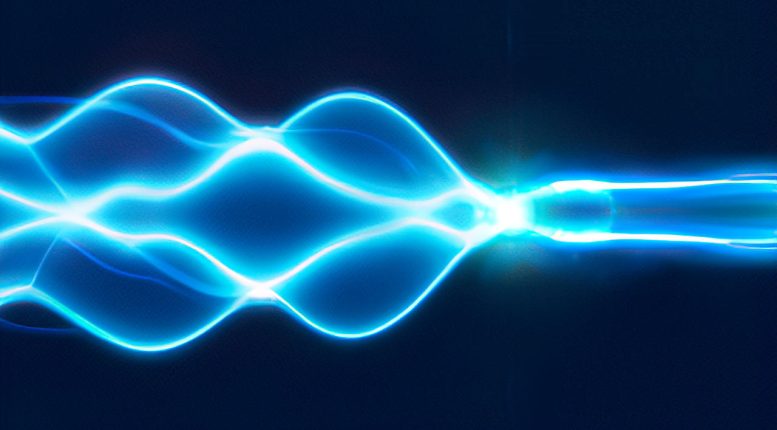
Anomalous bunching effect in which all photons coalesce into two output beams. Credit: Ursula Cardenas Mamani
In a paper recently published in Nature Photonics, scientists from the Center for Quantum Information and Communication – Brussels Polytechnic School of the Free University of Brussels report the discovery of an unexpected counter-example that challenges conventional understanding of photon bunching.
Niels Bohr’s principle of complementarity, a fundamental concept in quantum physics, essentially states that objects can exhibit either particle-like or wave-like behavior. These two mutually exclusive descriptions are well illustrated in the iconic double-slit experiment, where particles are impinging on a plate containing two slits.
If the trajectory of each particle is not watched, one observes wave-like interference fringes when collecting the particles after going through the slits. On the contrary, if the trajectories are watched, then the fringes disappear and everything happens as if we were dealing with particle-like balls in a classical world.
As coined by physicist Richard Feynman, the interference fringes originate from the absence of which-path information, so the fringes must necessarily vanish as soon as the experiment allows us to learn that each particle has taken one or the other path through the left or right slit.
Light does not escape this duality: it can either be described as an electromagnetic wave or it can be understood as consisting of massless particles traveling at the speed of light, namely photons. This comes with another remarkable phenomenon: that of photon bunching. Loosely speaking, if there is no way to distinguish photons and know which path they follow in a quantum interference experiment, then they tend to stick together.
This behavior can already be observed with two photons impinging each one on a side of a half-transparent mirror, which splits the incoming light into two possible paths associated with reflected and transmitted light. Indeed, the celebrated Hong–Ou–Mandel effect tells us here that the two outgoing photons always exit together on the same side of the mirror, which is a consequence of a wave-like interference between their paths.
This bunching effect cannot be understood in a classical worldview where we think of photons as classical balls, each one taking a well-defined path. Thus, logically, it is expected that bunching becomes less pronounced as soon as we are able to distinguish the photons and trace back which paths they have taken.
This is precisely what one observes experimentally if the two incident photons on the half-transparent mirror have, for example, distinct polarization or different colors: they behave as classical balls and do not bunch anymore. This interplay between photon bunching and distinguishability is commonly admitted to reflect a general rule: bunching must be maximum for fully indistinguishable photons and gradually decline when photons are made increasingly distinguishable.
Against all odds, this common assumption has recently been proven wrong by a team from the Center for Quantum Information and Communication (Brussels Polytechnic School of the Free University of Brussels) led by Professor Nicolas Cerf, assisted by his Ph.D. student, Benoît Seron, and his postdoc, Dr. Leonardo Novo, now a staff researcher at the International Iberian Nanotechnology Laboratory, Portugal.
They have considered a specific theoretical scenario where seven photons impinge on a large interferometer and probed the instances where all photons bunch into two output paths of the interferometer. Bunching should logically be the strongest when all seven photons admit the same polarization since it makes them fully indistinguishable, meaning that we get no information on their paths in the interferometer. Quite surprisingly, the researchers have discovered the existence of some instances where photon bunching is substantially strengthened – instead of weakened – by making photons partially distinguishable via a well-chosen polarization pattern.
The Belgian team took advantage of a connection between the physics of quantum interferences and the mathematical theory of permanents. By leveraging a newly disproved conjecture on matrix permanents, they could prove that it is possible to further enhance photon bunching by fine-tuning the polarization of the photons.
Aside from being intriguing for the fundamental physics of photon interference, this anomalous bunching phenomenon should have implications for quantum photonic technologies, which have shown fast progress over recent years.
Experiments aimed at building an optical quantum computer have reached an unprecedented level of control, where many photons can be created, interfered via complex optical circuits, and counted with photon-number resolving detectors. Understanding the subtleties of photon bunching, which is linked to the quantum bosonic nature of photons, is therefore a significant step in this perspective.
Reference: “Boson bunching is not maximized by indistinguishable particles” by Benoit Seron, Leonardo Novo and Nicolas J. Cerf, 15 June 2023, Nature Photonics.
DOI: 10.1038/s41566-023-01213-0

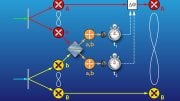
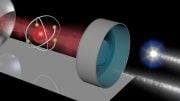
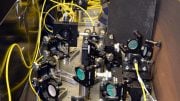
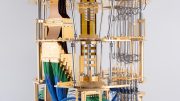
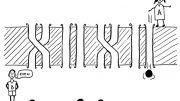
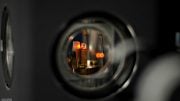
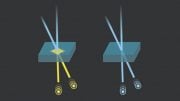
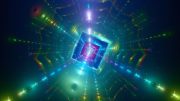
Sort of an article of faith that anything such as a photon would even exist in this universe; to believe otherwise would seem to be so counter intuitive.
For reference say, an environmental diameter is set where atoms must form specific molecules or elements forming resources then the atom is forced to split malignantly, how will the quantum state of an individual atom behave?
“objects can exhibit either particle-like or wave-like behavior. These two mutually exclusive descriptions …”
Standard journalist garbage.
Photons are particles carrying a rotating vector field, behaving as both a particle and a wave at the same time. The imaginary term in the wave equation itself is simply there to represent a vector rotation of a particle field. Interference effects can exist whether there is a single slit or two slits, in the former case light grazing the left edge of the single slit may interfere with light grazing the right edge.
Ultra wealthy families prefer to keep the lower classes hooked on religion, this is apparently the reason for the media’s historically near-constant bombardment of readers with Einstein and his “spooky action at a distance” stories where time is rendered a mere dimension simply because he liked to pretend light speed is not affected by gravity even as light’s direction is effectively bent by gravity.
Do you understand how light forms and spreads? Is the so-called Common Understanding scientific?
If you are interested, you can browse https://zhuanlan.zhihu.com/p/569722770.
Apparently there are a number of noise sources in such setups, so some introducing some form of pre-compensation into at least one of the inputs could be constructive.
Anyway, “light bunching” resembles to me the notion that if a light beam is bent gradually enough then adjacent photons in the beam will tend to remain close together in the beam regardless of any minor frequency differences, which would of course obviate assuming vacuum lightspeed is a constant regardless of gravity.
Consider also that a photon is understood to carry a mixture of frequencies in order for it to be of some finite length, giving it a lightspeed energy centroid position sufficient to treat it as a quantum of light and a particle with possibly a finite and flexible degree of nonlocality. Reasonably presuming interstellar gravity bends photons without breaking them apart means that the various frequencies of the photon are behaving as if entangled and as if being incapable of undergoing division into a spectrum. What bent spacetime perspectives do, in place of respecting light quanta, is not reasonable whatsoever and does not conserve total electric and gravitational field energy.